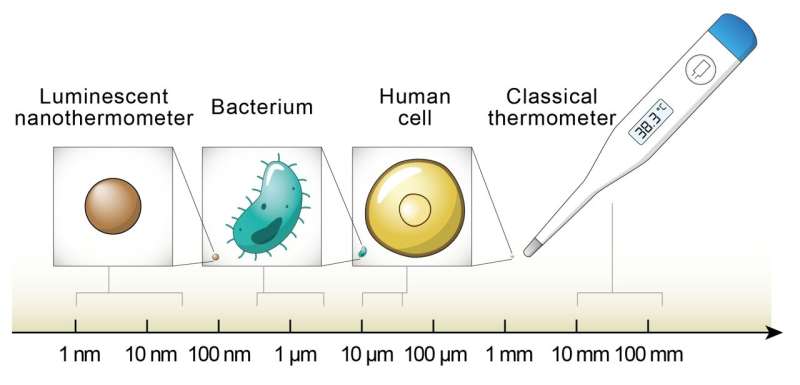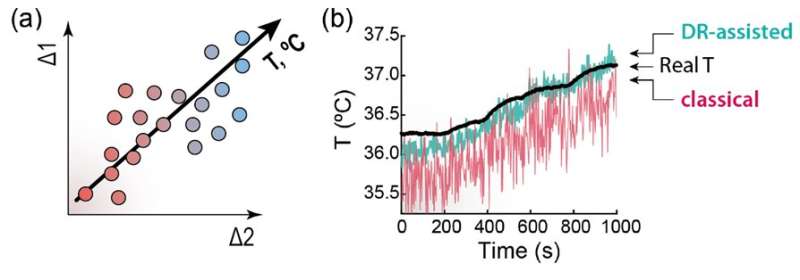Less is more: Dimensionality reduction as a general strategy for more precise luminescence thermometry

Temperature and heat exchange are at the base of biological processes throughout the realm of Nature. Several of these biological processes are associated with temperature changes on the order of a few degrees or even below 0.1 degrees Celsius. For example, in reptiles a difference of less than one degree in the egg incubation temperature determines the sex of the newborn. The human body is no exception: a small temperature increase above the basal level could alter cell dynamics or induce the dismantling of a tumor matrix, and during seizures changes in brain temperature of a few decimal points occur. To reliably monitor these processes, approaches that minimally perturb the studies system and have a thermometric precision below 0.1 degrees Celsius are needed.
To this end, in a new study published in Light: Science & Applications, a team of scientists from Spain and Portugal has cracked the code for an increased precision in the thermal readout using luminescent nanothermometers. These are nanomaterials whose optical properties are sensitive to temperature changes, and they can be inserted in biological (micro)environments to act as temperature nanoprobes down to the single-cell level. With their reduced size, they comply with the prerequisite of minimal perturbation of the probed system. However, when operating in aqueous environments, the precision in the readout of the temperature is generally above 0.1 degrees Celsius.
To calibrate a luminescent nanothermometer, changes in the optical properties of the nanomaterial are quantitatively correlated with variations in the temperature of the surrounding environment. This calibration passes through the selection of a suitable thermometric parameter and the acquisition of a calibration dataset, meaning that the photoluminescence (photon absorption followed by photon emission) of the nanothermometer is recorded as a function of a set of temperatures. Through the use of large-data analysis approaches collectively referred to as dimensionality reduction, the researchers have demonstrated that it is possible to automatize the selection of the thermometric parameter that maximizes the precision of the thermometric approach.

"The calibration of a luminescent nanothermometer used to entail a tedious trial-and-error approach wherein different thermometric parameters, like color and intensity changes, were independently tested. And, while the parameter ultimately selected was the best among the ones investigates, there was no guarantee that it was THE best one. With the approach we propose, one can easily plug in a calibration dataset and you are automatically rewarded with the highest precision that your nanothermometer can afford," the scientists said.
"To achieve this result, we employed mathematical approaches that are at the base of technologies rapidly becoming mainstream in our society, like face and voice recognition and noise canceling devices. These dimensionality reduction approaches are powerful algorithms that are able to recognize the most meaningful features of a class of objects and disregard smaller details that are overall less meaningful. This training of the algorithm enables, for example, the recognition of objects."

"Dimensionality reduction approaches allow to tap into the full potential of luminescence nanothermometry, ensuring that every time the nanothermometer one is using is working at highest standards. We can now really consider using luminescent nanothermometry to monitor previously elusive temperature fluctuations that occur in biological systems and correlate them with physiological events."
The researchers added that they "are confident that we will see a blooming of examples wherein similar mathematical approaches are employed to minimize the human component and improve the performance of sensing technologies."
More information: Erving Ximendes et al, Less is more: dimensionality reduction as a general strategy for more precise luminescence thermometry, Light: Science & Applications (2022). DOI: 10.1038/s41377-022-00932-3
Journal information: Light: Science & Applications
Provided by Chinese Academy of Sciences





















